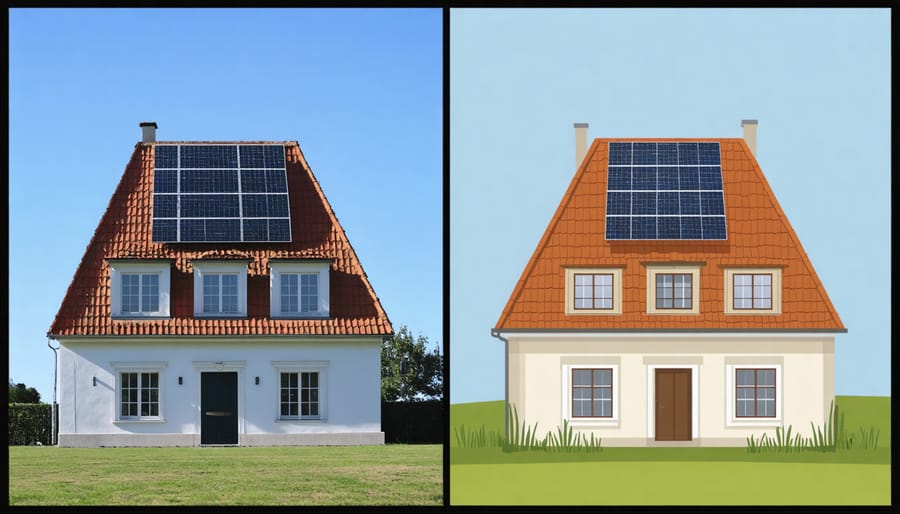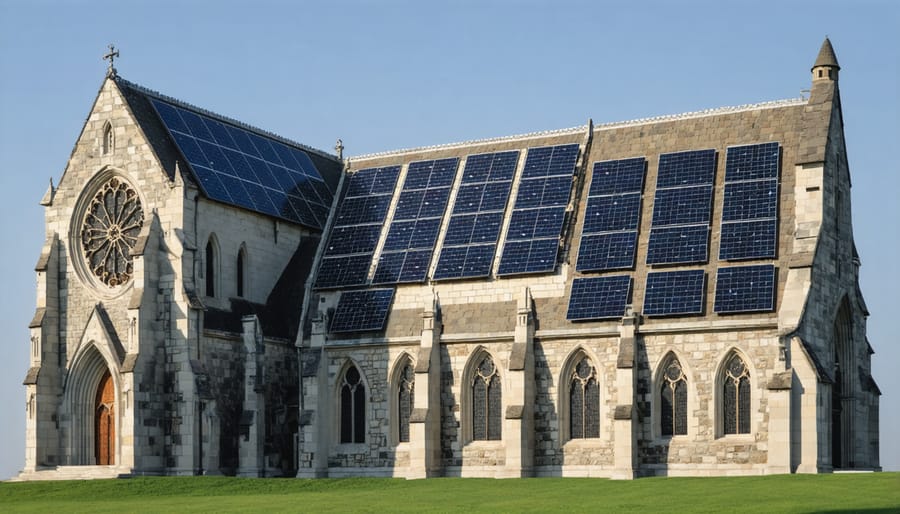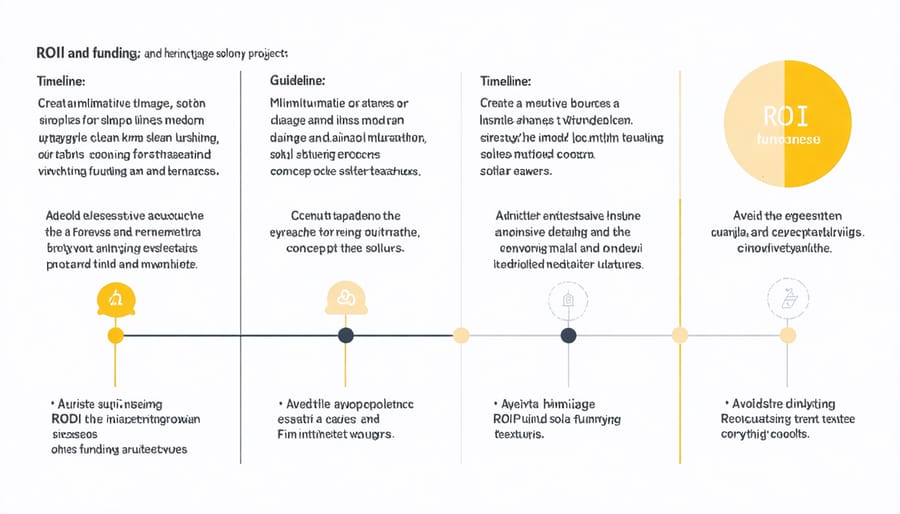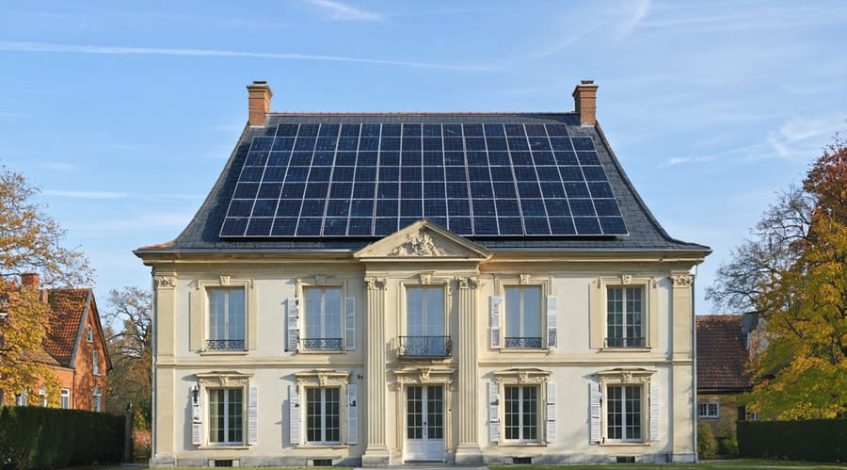Balancing heritage preservation with renewable energy adoption presents a transformative opportunity for historical properties to reduce their carbon footprint while maintaining architectural integrity. Modern solar technologies, including thin-film panels and solar slates, now seamlessly integrate with protected structures, offering up to 60% energy cost reduction without compromising historical value. Leading institutions, from centuries-old universities to protected medieval towns, have successfully implemented community-driven green energy initiatives while preserving their cultural significance. Through careful planning and innovative engineering solutions, heritage buildings across Europe and North America demonstrate that sustainable energy adoption can enhance, rather than diminish, the longevity and relevance of historical architecture in our carbon-conscious world. Property managers and preservation specialists now have access to an unprecedented range of conservation-friendly renewable technologies, supported by specialized funding schemes and expert guidance tailored to heritage properties.
The Preservation-Sustainability Challenge
Regulatory Requirements
Heritage buildings are subject to strict regulatory frameworks that govern both preservation and energy efficiency improvements. Property owners must navigate dual compliance requirements: historic preservation regulations and modern energy performance standards. In most jurisdictions, modifications to heritage structures require approval from local conservation authorities and must adhere to specific guidelines designed to protect architectural integrity.
Key regulatory considerations include the Secretary of the Interior’s Standards for Rehabilitation in the United States and similar frameworks internationally. These standards typically require that energy efficiency improvements be reversible and minimize impact on historical features. Many jurisdictions now offer special provisions for heritage buildings within their building codes, acknowledging the unique challenges of balancing preservation with sustainability.
Energy efficiency requirements often include specific exemptions or alternative compliance paths for listed buildings. For instance, some regions allow heritage properties to meet adjusted performance targets or implement alternative measures when standard solutions would compromise historical value. Property owners should consult with preservation specialists and energy consultants to develop compliance strategies that satisfy both conservation requirements and energy efficiency standards while maintaining eligibility for available incentives and grants.
Aesthetic Considerations
Integrating sustainable energy solutions into heritage buildings requires careful consideration of aesthetic impact to maintain the property’s historical character. Visual preservation guidelines typically emphasize minimal alterations to significant architectural features and street-facing facades. Modern solutions like solar panels and wind turbines must be positioned thoughtfully, often on rear elevations or behind parapet walls to minimize visibility from public areas.
Many preservation authorities now recognize the need to balance historical authenticity with sustainability goals. They frequently recommend reversible installations that don’t permanently alter the building’s structure or appearance. Color-matching and careful placement of equipment can help new installations blend seamlessly with existing features. For example, solar tiles designed to mimic traditional slate or terra cotta roofing materials offer an elegant solution for heritage properties.
Screening methods such as traditional architectural elements, vegetation, or period-appropriate enclosures can effectively conceal modern energy infrastructure while maintaining historical integrity. Successful projects often incorporate these elements during the planning phase, ensuring that sustainable technologies enhance rather than detract from the building’s cultural value.
Modern Solar Solutions for Historical Properties
Innovative Installation Methods
Modern installation methods for heritage buildings prioritize preservation while enabling sustainable energy integration. Non-invasive mounting systems utilize existing structural elements and innovative clamping technologies that eliminate the need for permanent alterations to historical facades or rooflines.
Reversible solar panel installations employ specialized rail systems that distribute weight across existing roof structures without penetrating traditional materials. These systems often feature adjustable brackets and removable components, ensuring that future restoration work remains uncompromised. Advanced micro-mounting techniques allow for precise placement that respects architectural features while maintaining optimal energy generation.
For ground-mounted solutions, archeologically-sensitive foundation systems minimize soil disruption through surface-weighted bases and removable anchor points. These installations can be completely dismantled without leaving lasting impact on the historical landscape.
Innovative cable management solutions conceal modern electrical systems within existing service routes, utilizing historical conduits and architectural features. This approach maintains the building’s authentic appearance while meeting contemporary safety standards.
Recent developments include thin-film solar technologies that can be integrated into traditional roofing materials and removable solar tiles that match historical patterns. These solutions provide energy generation capabilities while preserving the visual integrity of heritage structures.
Building management systems incorporate smart monitoring technology that allows for real-time adjustment and maintenance without physical modification to protected structures, ensuring both energy efficiency and preservation goals are met.
Low-Profile Solar Technologies
Recent advancements in solar power solutions have revolutionized how heritage buildings can integrate renewable energy without compromising their historical integrity. Solar tiles, designed to mimic traditional roofing materials, seamlessly blend with existing architecture while generating clean energy. These tiles are available in various styles, including slate and terracotta, making them particularly suitable for listed buildings and conservation areas.
Thin-film solar panels offer another discreet option, featuring flexible, lightweight materials that can be applied directly to various surfaces. Their minimal profile and adaptability make them ideal for curved roofs and non-traditional installations. Some variants achieve efficiencies of up to 20% while maintaining a virtually invisible presence from street level.
Building-integrated photovoltaics (BIPV) represent the latest innovation in low-profile solar technology. These systems incorporate solar cells into building materials themselves, such as windows, facades, and skylights. The result is a dual-purpose solution that generates electricity while serving as functional building components.
Color-matched solar panels are gaining traction in heritage applications, with manufacturers now offering modules in various hues and patterns. These customized solutions ensure visual harmony with existing structures while maintaining optimal energy generation capabilities. When combined with advanced mounting systems, these panels can be installed at angles that minimize their visibility while maximizing solar exposure.

Smart Integration Strategies
Several heritage sites worldwide have successfully integrated sustainable energy solutions while preserving their historical integrity. The Reichstag building in Berlin stands as a prime example, utilizing a sophisticated solar array system that complements its historic architecture while generating 85% of its energy needs. The installation’s design maintains the building’s aesthetic value through careful placement and modern transparent panels.
In the United States, the historic Bullitt Center in Seattle demonstrates how century-old building techniques can merge with cutting-edge renewable technology. The renovation incorporated both solar panels and geothermal systems, achieving net-zero energy status while preserving its original 1920s facade.
The Vatican City has also embraced sustainable integration, with the Paul VI Audience Hall featuring an innovative solar panel roof design that respects the building’s cultural significance. The installation generates 300 megawatt hours annually, reducing the Vatican’s carbon footprint while maintaining its architectural heritage.
These successful implementations share common strategies:
– Reversible installation methods that prevent permanent alterations
– Custom-designed mounting systems that minimize visual impact
– Use of modern materials that complement historical aesthetics
– Strategic placement of equipment in less visible areas
– Integration of smart monitoring systems for optimal performance
These examples prove that with careful planning and innovative approaches, heritage buildings can successfully adopt sustainable energy solutions without compromising their historical value.
Success Stories: Heritage Solar Projects

Historic Church Renovation
St. Michael’s Cathedral in Bristol exemplifies how historic buildings can embrace renewable energy while preserving their architectural heritage. In 2021, the 15th-century church underwent a comprehensive renovation that included the installation of a 50kW solar array, becoming one of several successful community projects championing sustainable preservation.
The installation presented unique challenges due to the building’s Grade I listed status. Engineers employed innovative mounting systems specifically designed for heritage structures, using non-penetrative fixtures to protect the original slate roof. The solar panels were strategically positioned on the south-facing roof, concealed from street view by the building’s Gothic parapets.
The system generates approximately 45,000 kWh annually, meeting 70% of the cathedral’s electricity needs and reducing carbon emissions by 25 tonnes per year. The project’s success lies in its careful balance of modern technology with historical preservation, achieved through close collaboration between conservation architects, renewable energy specialists, and heritage authorities.
The renovation also included LED lighting upgrades and a smart building management system, further enhancing energy efficiency. The project’s total cost of £180,000 was offset by heritage grants and community fundraising, with an expected return on investment within eight years through reduced energy costs and feed-in tariff payments.
Victorian Manor Energy Upgrade
The Blackwood Manor, a Grade II listed Victorian residence in Somerset, exemplifies how heritage properties can successfully integrate modern renewable energy solutions while preserving historical integrity. In 2021, the property underwent a comprehensive energy upgrade that reduced its carbon footprint by 75% while maintaining its distinctive architectural features.
The project utilized innovative solar slate tiles, specifically designed to match the original Welsh slate roofing. These solar slates were installed on the south-facing rear roof slope, generating 8.5 kW of power while remaining virtually invisible from street level. The installation required close collaboration with local conservation officers and heritage specialists to ensure compliance with preservation guidelines.
To maximize energy efficiency, the project incorporated a ground-source heat pump system, carefully positioned within the estate’s grounds to minimize visual impact. The pump provides both heating and hot water, replacing the original oil-fired boiler system. Secondary glazing was installed behind the original sash windows, significantly improving thermal performance without altering the building’s external appearance.
The £85,000 investment is projected to deliver annual energy savings of £7,200, with an expected return on investment within 12 years. The success of this project has established a valuable blueprint for similar heritage properties, demonstrating that historical preservation and sustainable energy adoption can work in harmony when approached with careful planning and appropriate technology selection.

Financial Considerations and Support
Heritage-Specific Grants
Several grant programs specifically support the integration of sustainable energy solutions in heritage buildings. The National Heritage Preservation Grant offers funding up to $500,000 for projects that demonstrate innovative approaches to energy efficiency while maintaining historical integrity. Local preservation societies and state historic offices frequently provide matching grants ranging from $10,000 to $100,000 for renewable energy installations.
The Historic Building Energy Retrofit Fund, available in multiple regions, covers up to 40% of project costs for qualifying properties. These grants often include provisions for renewable energy education and community outreach components, ensuring broader impact beyond individual properties.
International organizations like UNESCO and the World Monuments Fund also provide specialized funding for sustainable heritage projects. Applications typically require detailed preservation plans, energy assessments, and demonstrated commitment to long-term sustainability goals. Property owners should consult with preservation specialists and energy consultants to maximize their funding opportunities and ensure compliance with grant requirements.
Long-term Cost Benefits
The implementation of sustainable energy solutions in heritage buildings demonstrates significant long-term cost advantages. Initial assessments indicate that property owners typically recover their investment within 5-7 years through reduced energy expenses. Energy-efficient systems in historic buildings can reduce operational costs by 30-50% annually, with some properties reporting savings of up to $2.50 per square foot in utility expenses.
Beyond direct energy savings, heritage properties with sustainable modifications often experience a 7-10% increase in market value. This appreciation is attributed to growing market demand for environmentally responsible properties and lower operating costs. Insurance companies frequently offer reduced premiums for buildings with updated sustainable systems, recognizing their decreased risk profile.
Government incentives and tax benefits further enhance the financial appeal. Many jurisdictions offer specific grants and tax credits for sustainable upgrades to heritage properties, potentially covering 20-30% of project costs. The combination of reduced energy consumption, increased property value, and available incentives creates a compelling financial case for sustainable energy integration in heritage buildings, with most projects achieving positive ROI within the first decade of implementation.
The integration of sustainable energy solutions in heritage buildings represents a crucial intersection of preservation and progress. As we move forward, the success of heritage sustainable energy initiatives will depend on three key factors: technological innovation, policy support, and stakeholder collaboration. Emerging technologies continue to offer more discrete and efficient solutions that respect historical integrity while delivering meaningful energy savings. These advances, coupled with evolving preservation guidelines, create new opportunities for sustainable retrofitting without compromising cultural value.
The future of heritage sustainable energy lies in developing standardized yet flexible approaches that can be adapted to diverse historical contexts. Investment in research and development will be essential to create more specialized solutions that address the unique challenges of heritage properties. Additionally, the establishment of clear regulatory frameworks and incentive programs will help drive adoption and ensure consistent implementation across different jurisdictions.
Success stories from around the world demonstrate that with careful planning and appropriate expertise, heritage buildings can achieve significant energy efficiency while maintaining their historical significance. Moving forward, the focus should be on building capacity among preservation professionals, energy consultants, and property managers to facilitate more widespread adoption of sustainable solutions.
By embracing this balanced approach to heritage sustainable energy, we can ensure that our architectural heritage remains both culturally relevant and environmentally responsible for future generations. The path forward requires continued commitment to innovation, preservation-sensitive implementation, and collaborative problem-solving among all stakeholders involved.

